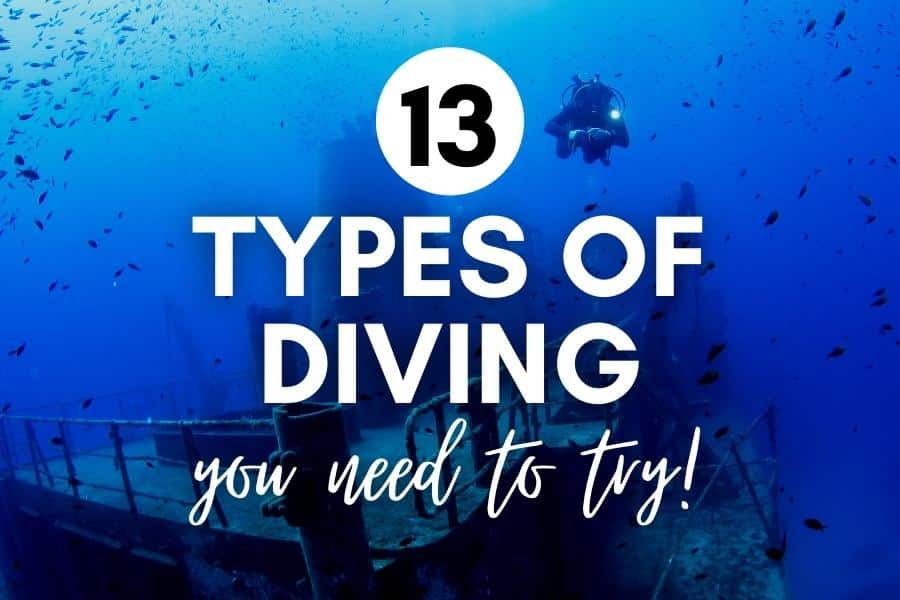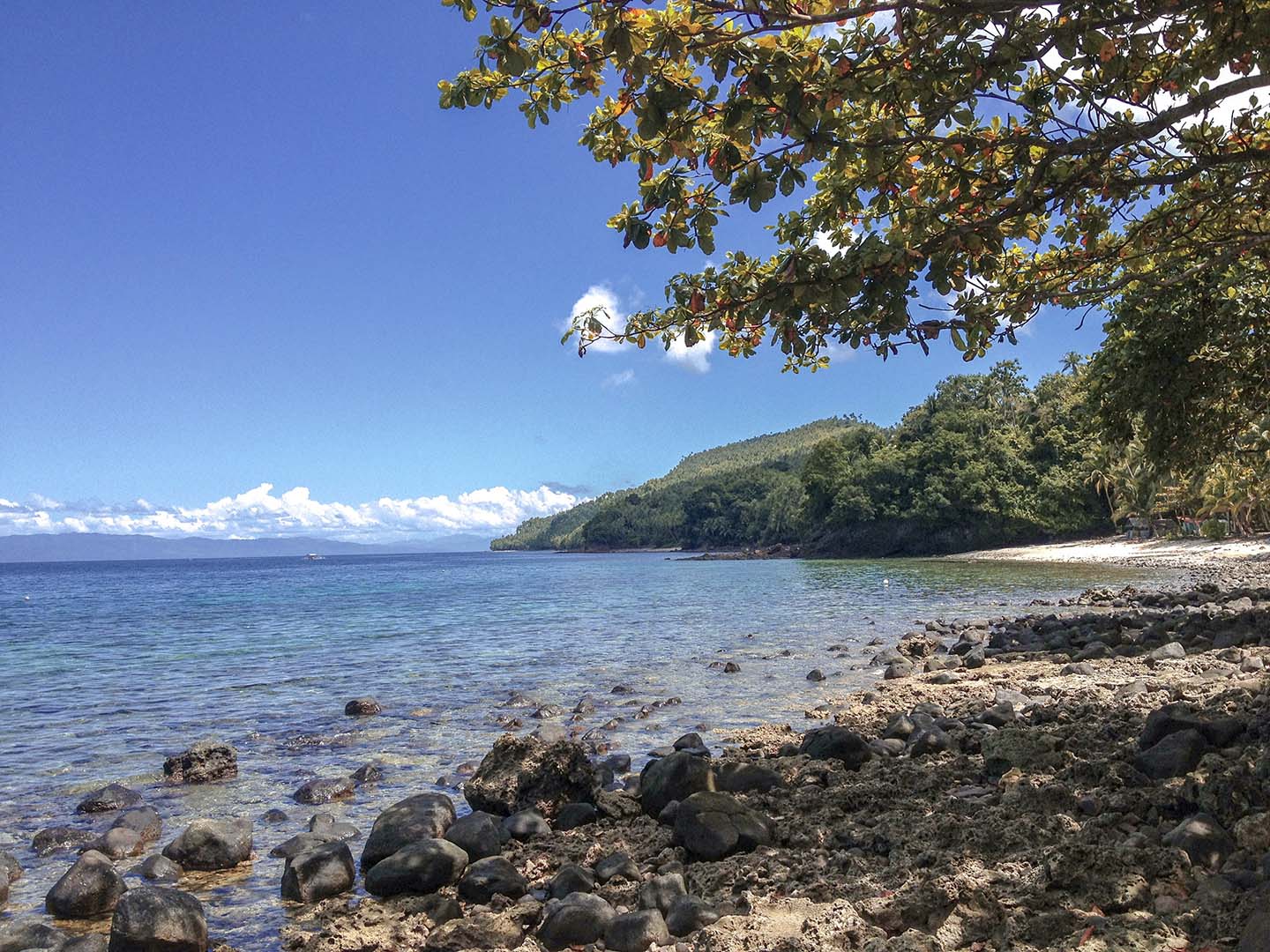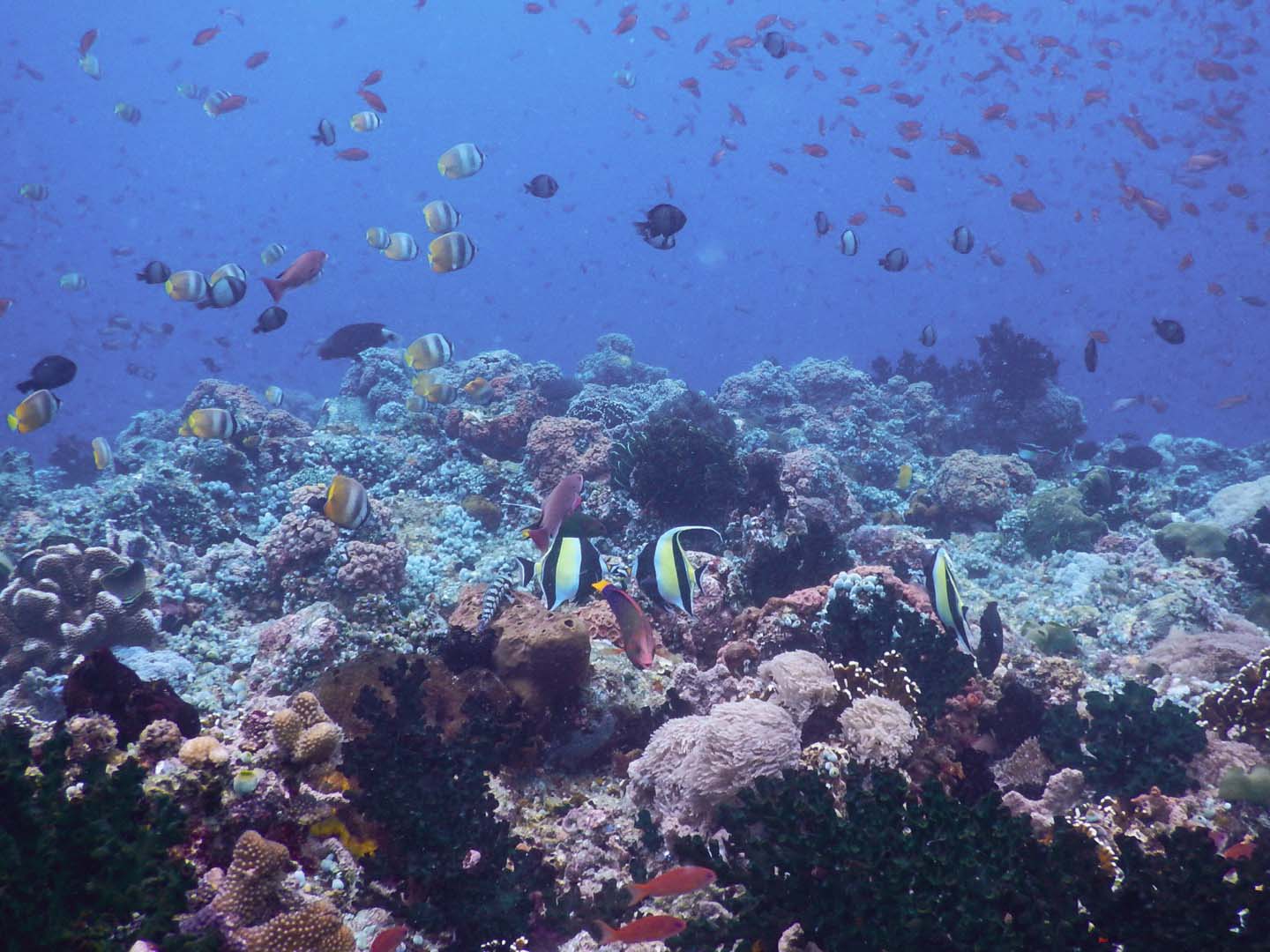When you think of scuba diving the first thing that comes to mind is you exploring the ocean to find a variety of diverse marine life. But did you know that there are actually different types of diving that you can enjoy as a scuba diver?
While most people, get attracted to scuba diving because of the beautiful reef scapes and ocean wildlife, they soon find out that there is more to diving than just seeing fish.
After completing your scuba diving certification course will discover that there are so many more things you can do while underwater. One of the benefits of scuba diving is that there is always room for growth.
From exploring caves to wrecks, to night dives and more, it is not really surprising why many individuals become addicted to scuba diving.
If you find yourself feeling bored and unimpressed with your fish encounters lately, you might want to get your fins wet in a different type of diving. While I can’t ever imagine getting tired of an amazing sea turtle encounter or finding Nemo on the reef, I know this is not the case for many divers.
If you’re starting to think that diving might not be for you, don’t give up on it just yet. Perhaps you just haven’t found the right kind of diving for you!
Continue reading if you want to find out the different types of diving you can try and the different types of scuba diving certifications you can get. Who knows, you might end up adding more to your list of favorite things to do while scuba diving.
1. Deep diving
When you receive your Open Water diving certification, you would have been trained to dive up to 18 meters (60 feet). While some new divers are happy to swim along in these depth limits, others might feel restricted. The ocean is deep and expansive and once in a while, you just want to be able to see a different side of it.
The deeper you go, the terrain and marine diversity also change. While some species thrive in shallower waters, others can only be found in deeper areas. Many other types of diving, which will be covered in this post, will require you to do deep dives so having proper training and certification to be able to go beyond 18 meters is worth pursuing.
If you wish to do deep dives, you will need to get additional certification such as Advanced Open Water. In some dive agencies, they also offer a Deep Diver Course which can teach you skills needed to dive up to 30 meters (100 feet.)
2. Drift diving
At one point while scuba diving or swimming in the ocean, you’ve felt the strong power of the ocean. Instinctively, you try to fight it or go against it. Getting pulled in by the ocean’s current can be scary, however, there are also instances when it can be fun. Sometimes, you can just let go and allow the current to safely take you on a relaxing ride.
Drift diving is a type of diving where you take advantage of the ocean’s natural currents. Rather than fighting the current, you just go with the flow. Depending on the strength of the current you might not even have to fin as you explore the ocean floor. You simply maintain your neutral buoyancy and allow the current to take you for a free ride. This can be very delightful as you can basically “sit there and do nothing” while enjoying the views.
There are also drift dives that can go really fast which is perfect for adrenaline junkies. There are dive sites all over the world where you can safely drift so you don’t worry about being swept out into the open water or be forced down by a down current. Strong currents also attract bigger marine animals like manta rays and sharks so there is also a greater chance of seeing these magnificent creatures.
While it is not a requirement, you can also take a Drift Diver Course that will help you build confidence underwater.
3. Wreck diving
Wreck diving is another type of diving where you explore artificial or man-made structures. The ocean is filled with different wreckages. From sunken ships and aircrafts to artificial reefs and sunken statues, wrecks are another side of scuba diving that you should experience.
Many recreational divers love exploring wrecks as it often has an interesting story to tell. Many of the best wrecks around the world played an important role in history. Being able to see first-hand and explore a piece of the past can be a thrilling experience.
Diving in wrecks may also require additional skills and challenges for scuba divers. There are many risks involved in penetrating wrecks so a Wreck Diver Course might be something you would want to take to safely do this.
4. Underwater photography or videography
One of the most popular kind of diving is underwater photography or videography. Once you have mastered your buoyancy skills and gained experience and confidence underwater, you can dabble into underwater photography.
Whether it is as a hobby or as a profession, scuba divers enjoy this type of diving for several reasons. One is being able to capture the beauty of the underwater world. Another is to be an ocean influencer and create awareness about the conditions of our oceans.
Many love taking their underwater cameras to document their experiences. While for many creative individuals, underwater photography is their artistic outlet.
Personally, this is one of my favorite things to do while scuba diving. I have a Canon G7X Mark II + Fantasea Housing when I dive. If you are looking to get into underwater photography or videography, here are my scuba camera recommendations for beginners.
5. Night diving
Another popular underwater diving activity is night diving. While the thought of diving in the dark can be terrifying, diving at night is actually a fun and enjoyable experience once you overcome your fears. Night diving can be done safely by diving in shallow waters and diving in areas you are already familiar with.
And of course, you shouldn’t go night diving without carrying an underwater torch or flashlight. Here are some of my top recommendations for the best dive lights for night diving.
One of the best things about night diving is that the reef is equally vibrant and alive with creatures hunting at night. You can spot more marine creatures like crabs, shrimps, squids, octopus, cuttlefish at night. Different critters come out to play so you can encounter marine creatures that you would not normally find during the day.
If you want to know more about scuba diving in the dark, you should read my post on What Is Night Diving Like? It contains stories of my first night dive, as well as other night dives that didn’t turn out so great. You can also read my article on my night diving tips if you are planning on night diving for the first time.
For divers who are interested in night diving, you can also take a Night Diver Course to build your confidence while diving in the dark.
6. Fluorescent Diving
Another unique experience while night diving is fluorescent diving. This type of diving makes use of UV light underwater so you get to see the reef under a different light. It can be very “trippy” seeing the reef glow in the dark because of the special underwater light you use during these uv night dives.
Here’s a video of night dive I did in Fiji where we used a UV light in some portions of the dive.
7. Bonfire diving/ Blackwater diving
Another type of night diving that is gaining popularity are the bonfire diving and black water diving. These two kinds of diving attract underwater photographers because of the uncommon ocean creatures one can encounter during these dives.
Blackwater diving is done by scuba diving in open water late at night and setting up light baits to attract plankton. From deep-sea waters, the plankton migrates towards shallow waters where divers take the opportunity to observe and photograph them. Bonfire diving works similarly but it is done in shallower coastal areas.
By taking advantage of how planktons behave during these night dives, underwater photographers are able to photograph rarely seen ocean critters. Blackwater or bonfire photographers in recent years have been able to capture on-film fish in their larval state, which has always been elusive or hard to find.
If you would like to know more about blackwater diving, read my post on Blackwater Diving for Beginners: Complete Guide for First-Timers
8. Liveaboard Diving
Liveaboard diving is a recreational scuba diving activity that requires you to live on a boat or ocean vessel for one or more nights so you can visit distant dive sites. A liveaboard vessel can accommodate between 6-30 divers at a time (sometimes even more!) depending on the size of the charter.
Because you will be living on a boat for several days at a time and diving around 3-4 times a day, liveaboards can be costly. But anyone who has experienced liveaboard diving almost always says it is worth it. Many of the best places to dive in the world are in remote locations. To experience these paradises on earth, the only way to get there is through these liveaboards.
If you’re interested to know what it’s like, here’s an article I wrote of my first liveaboard experience on the Great Barrier Reef and my liveaboard experience in Tubbataha Reef.
You can also check out my post Liveaboard Diving for Beginners: A First Timer’s Complete Guide.
9. Cave diving
Cave or cavern diving is another kind of scuba diving that only a few divers participate in. Due to the number of risks involved in entering underwater caves, there are relatively fewer scuba enthusiasts who pursue this specialized activity. However, this does not stop scuba divers, from pursuing it.
There are many beautiful water-filled caves all over the world. The unique environment of caves attracts underwater explorers to pursue this different type of diving. At the same time, the physical and mental challenges involved in cave diving also attract many divers to get into this aspect of scuba diving.
Scuba divers interested in cave diving must undergo technical diving training. The scuba equipment and gear configurations are also different to allow divers to safely penetrate and explore caves. Diving caves requires a different set of skills and mindsets to safely explore these unique underwater terrain so you might want to take a Cave Diver Course.
10. Ice diving
Another chilling adventure divers can experience is Ice Diving. Naturally these kinds of diving can only be done in cold climates as you will be diving under ice. Ice diving also requires a special kind of training due to the additional risks and hazards involved.
For instance, when you go ice diving there is usually only one point of entry and exit. You could also get lost under the ice, experience hypothermia and experience equipment malfunctions due to the extremely cold water temperatures.
Unlike other recreational dives that can be done as a dive buddy pair, ice diving is done as a team to ensure safety. Scuba divers engaging in ice diving are always attached to a tether or safety line during the dive. They are also being monitored by someone on the surface. To learn more about this extreme scuba activity, take the Ice Diver Course.
11. Muck diving
Muck diving is a kind of diving that consists of exploring dive sites that consist of dark volcanic sand, sediments, and sometimes debris like dead corals or trash. Muck sites usually do not have many corals and they usually look like barren areas of sand. Initially, it might even look unimpressive to be diving in areas like these however if you look close enough what you find might surprise you.
Muck sites create the perfect environment for many of the weird and wonderful critters to live and thrive. The key to muck diving is being able to go close and to have good eyesight. Make sure your buoyancy is on point so you’re not disrupting the distinctive mucky habitat.
Many underwater photographers enjoy muck diving because you can find the tiniest and sometimes even the most bizarre-looking underwater subjects in these areas. So be ready to be amazed when you try muck diving.
Want to know what muck diving is like? Read my post about Muck Diving in Dauin to find out what I saw and why I loved it so much!
12. Ocean Conservation Diving
Scuba divers are one of the biggest advocates of our oceans so it is not surprising that many scuba divers engage in ocean conservation work. Many divers go scuba diving with the intention of doing something good for the environment.
You will find divers who join yearly events like International Coastal Cleanup Day. Some organizete thier own underwater cleanup dives to remove trash from our oceans. Some divers participate in reef surveys and ocean research. And others might even do coral planting.
I actually learned how to scuba dive through Coral Cay Conservation– a non-profit marine conservation organization that works to protect the health of coral reefs. There are many similar programs like this where you can dive while helping the ocean. If this is something that might interest you, you can check with your local community on how you can participate and do some good while scuba diving.
If you love learning about marine life and ocean conservation, check out this list of distinctive specialty courses for scuba divers who love marine life.
13. Technical Diving
Technical diving is a type of diving that exceeds the standard recreational diving limits set by most dive agencies. If you want to try deep diving and wreck diving beyond 40 meters or cave diving, it is recommended that you take a tech diving certification course to reduce the risks of serious injury or even death. Tech diving gives you specialized training so you can properly and safely explore these unique underwater environments.
If this is something that interests you, dive agencies like PADI, TDI, GUE, offer this highly specialized kind of scuba diving.
Pin for later
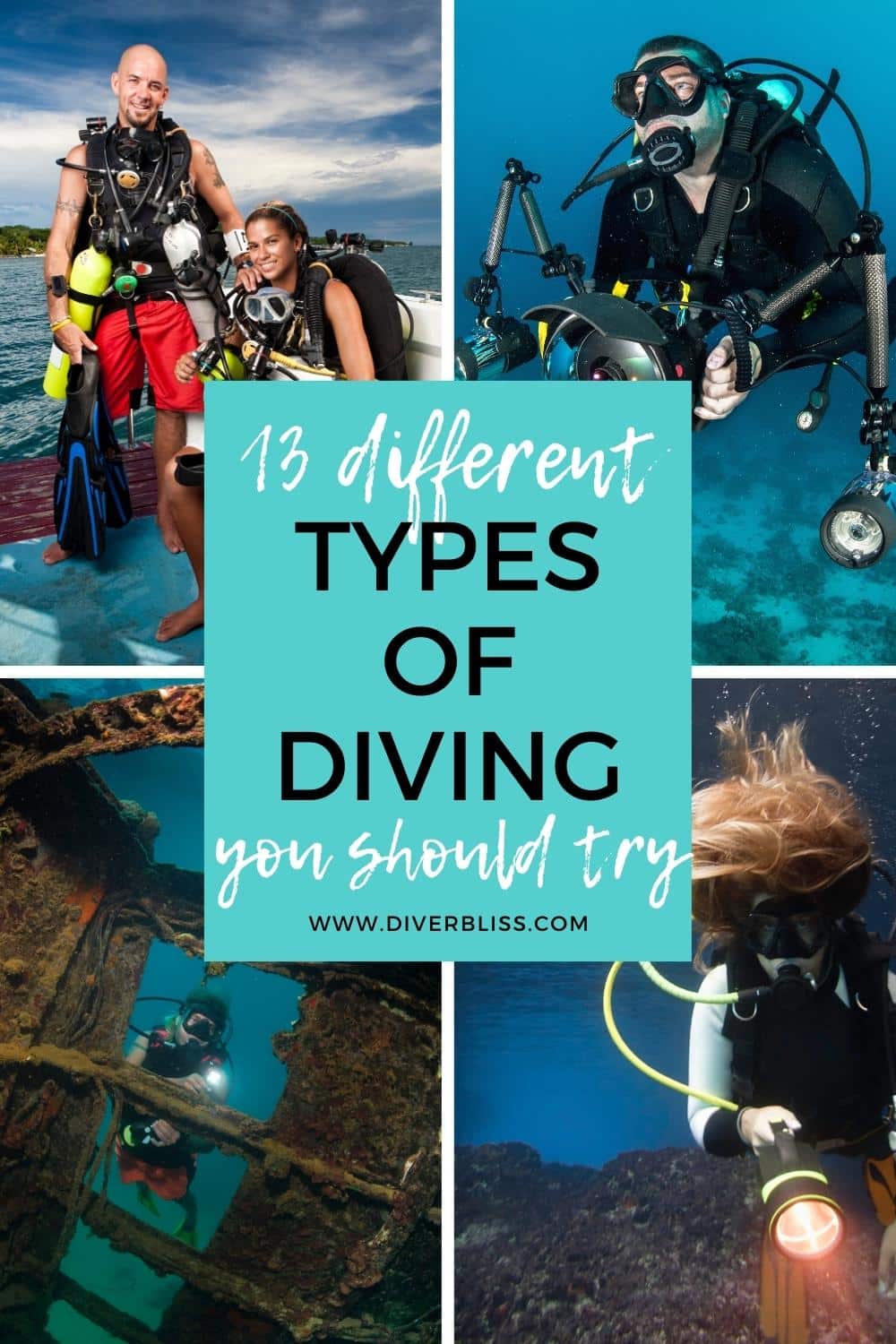
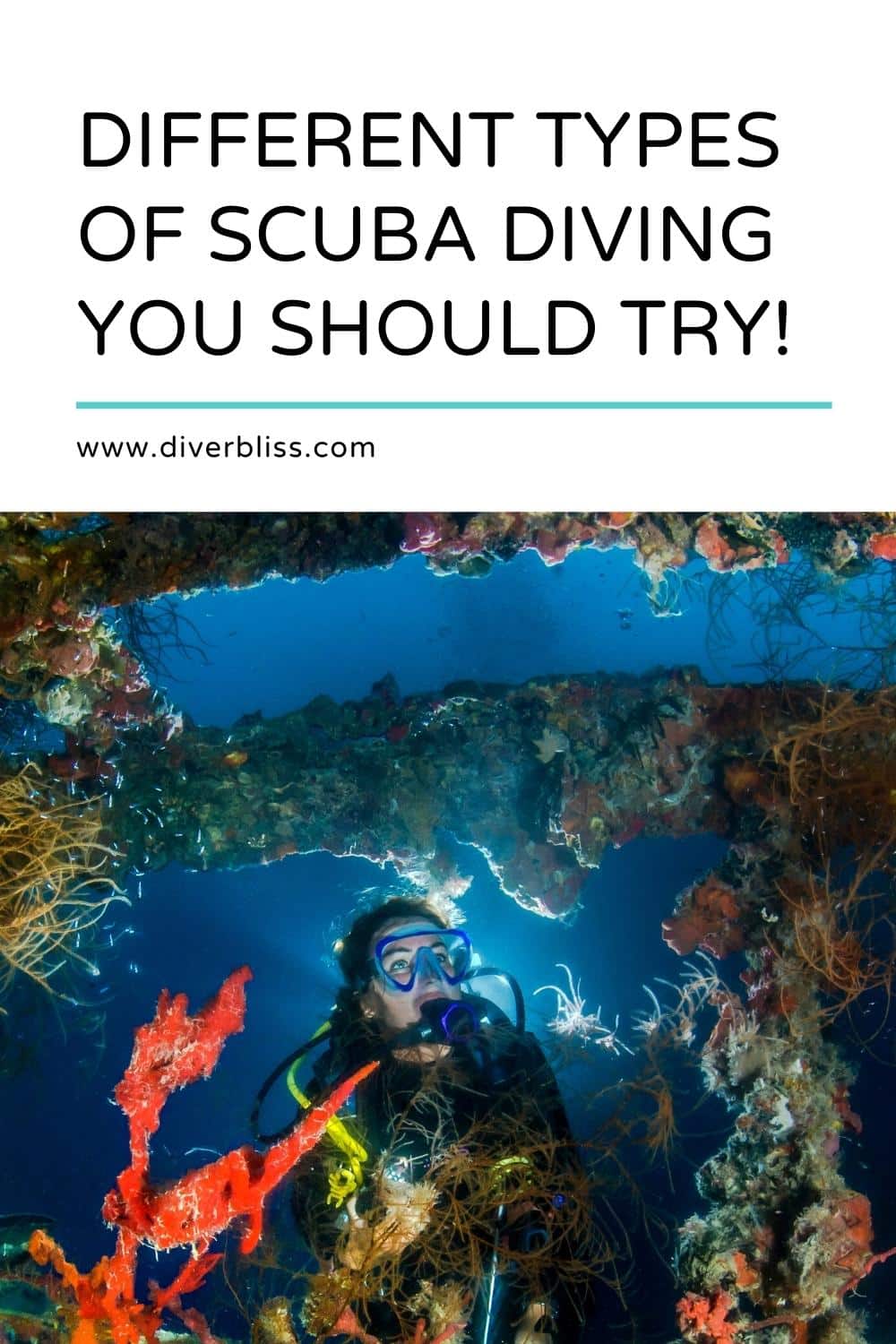
While there are only 13 types of scuba diving mentioned on this list, there are actually many more that you can enjoy and try. Recreational scuba diving is continuously evolving and changing. And with a growing community of divers from different countries, backgrounds and interest, no doubt there will be many more types of diving that will arise.
I am sure that you will always find something new and different about scuba diving that will pique your interest. Try any one of these underwater diving activities, and I promise, you won’t regret it.
What kinds of scuba diving have your tried? What types of diving certifications have you acquired? Which type of diving do you want to try next? Leave a comment below!
